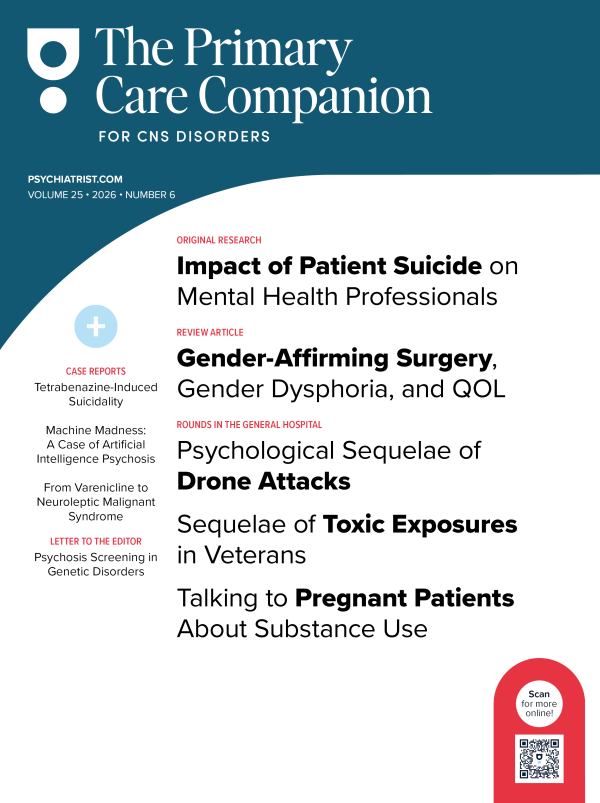Because this piece does not have an abstract, we have provided for your benefit the first 3 sentences of the full text.
Catatonia is a syndrome of motor dysregulation with disruptions in cognition, thought, and mood. It is characterized by several features including posturing, stereotypy, verbigeration, mutism, and echophenomena. Often overlapping with delirium, catatonia is most likely underdiagnosed in the hospital setting.

Neuropsychiatric Complications of Immunosuppressants:
A Case Report of Tacrolimus-Induced Catatonia in a Liver Transplant Recipient
Catatonia is a syndrome of motor dysregulation with disruptions in cognition, thought, and mood.1 It is characterized by several features including posturing, stereotypy, verbigeration, mutism, and echophenomena.2 Often overlapping with delirium, catatonia is most likely underdiagnosed in the hospital setting.3 Catatonia may result from infection, neurologic issues, metabolic derangements, vitamin deficiencies, substance withdrawal, or medications such as immunosuppressants. Recognition and treatment of catatonia is imperative to decrease morbidity and mortality. We discuss the case of a patient who exhibited features consistent with catatonia following treatment with tacrolimus, an immunosuppressant.
Case Report
Mr A, a 41-year-old white man 6 years post liver transplant with chronic kidney disease and primary sclerosing cholangitis, presented to the emergency department (ED) with complaints consistent with an upper respiratory tract infection. He was recently prescribed ciprofloxacin for suspected sinusitis. Laboratory values revealed transaminitis, a creatinine level of 2.5, and a tacrolimus level of 26.2 (4-20 ng/mL). An extensive workup was unremarkable, and he improved with fluids and antibiotics. He was discharged with amoxicillin/clavulanate and home medications including alprazolam 1 mg twice/day as needed, escitalopram 20 mg, lamotrigine 100 mg, mycophenolate 360 mg twice/day, and tacrolimus 1 mg twice/day.
He returned to the ED 12 hours later with grandiose delusions and agitation. Laboratory values were improved from his initial presentation, the drug screen was positive for benzodiazepines, and head computed tomography revealed mild frontal lobe atrophy. According to his family, he had experienced a similar episode 5 years prior following treatment with intravenous steroids and was prescribed lamotrigine for symptom management, which he had continued to date. Mr A was admitted to the psychiatric inpatient unit for presumed mania. Escitalopram was discontinued, and quetiapine was initiated for mania. Initially, his symptoms appeared to improve; however, by day 4, he was noted to be withdrawn, staring, and sitting motionless.
On day 7, he was transferred to the general medical floor for concern of delirium and tachycardia. On assessment by the psychiatric consult-liaison service, he was noted to be withdrawn, staring, rigid, and tachycardic with disorganized thoughts. EEG results were unremarkable. He screened positive for signs of catatonia (utilizing the Bush-Francis Catatonia Rating Scale4). He received a lorazepam (1 mg) challenge with improvement in rigidity, tachycardia, and thought disorganization. Neuroleptics were discontinued, and lorazepam 1 mg 4 times/day was initiated. By day 12, his mental status had improved, and he was discharged on day 14.
Discussion
Approximately 90% of organ transplant recipients receive calcineurin inhibitors.5 Mild-to-moderate neuropsychiatric complaints occur in 40%-60% of patients prescribed tacrolimus. Another 5%-8% of these patients develop severe manifestations including catatonia.6 Catatonia most likely results from imbalances in γ-aminobutyric acid (GABA), glutamate, and dopamine. The neurobiology of catatonia derives mostly from clinical practice with benzodiazepines, the primary pharmacologic treatment, though N-methyl-d-aspartate receptor antagonists have been shown to have some efficacy.7 How tacrolimus induces catatonia remains poorly understood; however, calcineurin may modulate both GABA and glutamate activity.6,8
Drug-drug interactions occurring with tacrolimus may produce serious consequences.5,9 Tacrolimus is a substrate of cytochrome P450 (CYP) 3A4. Patients may receive other drugs either inducing or inhibiting metabolism through the cytochrome pathways. Mr A’s tacrolimus level was initially elevated and may have resulted from interactions with ciprofloxacin, a CYP3A4 inhibitor. This elevation most likely influenced the severity of Mr A’s symptomatology; however, his symptoms persisted even once levels were therapeutic. This illustrates that symptoms are not directly reflective of serum drug concentrations, as our patient’s symptoms persisted at normal levels.5
Also pertinent to this case is Mr A’s history of intermittent benzodiazepine use. Case reports have described catatonia occurring from alcohol or benzodiazepine withdrawal.10 Collateral history, however, indicated sporadic use of alprazolam by our patient. Likewise, on assessment, there were no signs suggestive of overt benzodiazepine withdrawal.
Conclusions
Transplant recipients frequently receive calcineurin inhibitors like tacrolimus that may cause neuropsychiatric manifestations including catatonia. Drug-drug interactions may increase the likelihood of the development of catatonia. Correct identification and treatment of catatonia can help decrease morbidity and mortality.
Published online: January 9, 2020.
Potential conflicts of interest: None.
Funding/support: None.
Previous presentation: Presented as a poster at the Association of Medicine and Psychiatry Conference; October 13, 2018; Chicago, Illinois; and the American Psychiatric Association’s Annual Conference; May 19, 2019; San Francisco, California.
Additional information: Patient information was de-identified to protect anonymity.
REFERENCES
1.Kahlbaum KL. Catatonia. Baltimore, MD: Johns Hopkins University Press; 1973.
2.Bush G, Fink M, Petrides G, et al. Catatonia, I: rating scale and standardized examination. Acta Psychiatr Scand. 1996;93(2):129-136. PubMed CrossRef
3.Fink M, Taylor MA. The catatonia syndrome: forgotten but not gone. Arch Gen Psychiatry. 2009;66(11):1173-1177. PubMed CrossRef
4.Bush G, Fink M, Petrides G, et al. Catatonia. I. Rating scale and standardized examination. Acta Psychiatr Scand. 1996;93(2):129-136. PubMed CrossRef
5.Lange NW, Salerno DM, Berger K, et al. Using known drug interactions to manage supratherapeutic calcineurin inhibitor concentrations. Clin Transplant. 2017;31(11):e13098. PubMed CrossRef
6.Chopra A, Das P, Rai A, et al. Catatonia as a manifestation of tacrolimus-induced neurotoxicity in organ transplant patients: a case series. Gen Hosp Psychiatry. 2012;34(2):209.e9-209.e11. PubMed CrossRef
7.Northoff G. Catatonia and neuroleptic malignant syndrome: psychopathology and pathophysiology. J Neural Transm (Vienna). 2002;109(12):1453-1467. PubMed CrossRef
8.Daniels J. Catatonia: clinical aspects and neurobiological correlates. J Neuropsychiatry Clin Neurosci. 2009;21(4):371-380. PubMed CrossRef
9.Fireman M, DiMartini AF, Armstrong SC, et al. Immunosuppressants. Psychosomatics. 2004;45(4):354-360. PubMed CrossRef
10.Oldham MA, Desan PH. Alcohol and sedative-hypnotic withdrawal catatonia: two case reports, systematic literature review, and suggestion of a potential relationship with alcohol withdrawal delirium. Psychosomatics. 2016;57(3):246-255. PubMed CrossRef
aDepartment of Psychiatry, University of Arkansas for Medical Sciences, Little Rock, Arkansas
*Corresponding author: Lauren E. Davis, MD, Department of Psychiatry, University of Arkansas for Medical Sciences, 4301 W. Markham, Slot 589, Little Rock, AR 72205 ([email protected]).
Prim Care Companion CNS Disord 2020;22(1):19l02481
To cite: Davis LE, Tripathi S. Neuropsychiatric complications of immunosuppressants: a case report of tacrolimus-induced catatonia in a liver transplant recipient. Prim Care Companion CNS Disord. 2020;22(1):19l02481.
To share: https://doi.org/10.4088/PCC.19l02481
© Copyright 2020 Physicians Postgraduate Press, Inc.
Please sign in or purchase this PDF for $40.00.





